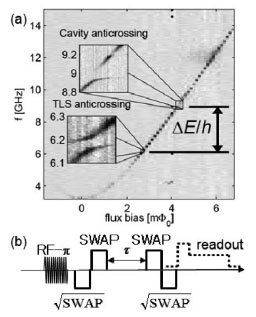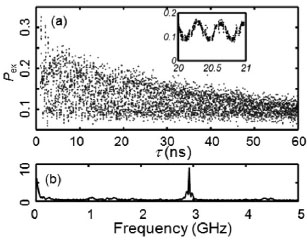Physical Science Laboratory, *Optical Science Laboratory
Circuit quantum electrodynamics in superconducting circuits has demonstrated
the coupling of superconducting qubits to microwave photons in a superconducting
resonator, paving a way for scaling up the qubit system [1]. During these
experiments, microscopic two level systems (TLS) coupled to the qubit were
observed [2]. Here we report on the study of an entangled state of a microscopic
TLS and a macroscopic resonator by way of a superconducting flux qubit
[3].
A spectrum of the flux qubit depicted in fig. 1(a) shows two anti-crossings
at 6.17 GHz and 8.95 GHz. These represent the coupling of the qubit to
the TLS and the resonator, respectively. The coupling strengths were 55
MHz and 154 MHz. The qubit energy can be controlled by an external magnetic
flux through the qubit. Using a flux shift pulse, we can bring the qubit
on resonance with the TLS (or resonator) and create any entangled state
between the qubit and the TLS (or resonator). Utilizing such pulses we
realized an entangled state between the TLS and the resonator.
Figure 1(b) shows a pulse sequence to make this entangled state. First,
a microwave π-pulse prepares the qubit in the excited state |100> (where
the state is represented by |qubit, TLS, resonator>). Next a ![]() pulse brings the qubit on resonance with the TLS creating the entangled
state (|100>+|010>) /
pulse brings the qubit on resonance with the TLS creating the entangled
state (|100>+|010>) /![]() . Then a SWAP pulse between the qubit and the resonator realizes the entangled
state (|001>+|010>) /
. Then a SWAP pulse between the qubit and the resonator realizes the entangled
state (|001>+|010>) /![]() . The state then acquires a relative phase φ = ΔEτ/
. The state then acquires a relative phase φ = ΔEτ/![]() during a period of free evolution of a time τ . Here ΔE is the energy difference between the |001> and |010> levels. To observe this phase evolution we reverse our pulse sequence, we apply the
during a period of free evolution of a time τ . Here ΔE is the energy difference between the |001> and |010> levels. To observe this phase evolution we reverse our pulse sequence, we apply the ![]() pulse and then the SWAP pulse followed by the readout of the population of the qubits excited state Pex. Figure 2 shows that Pex as a function of τ oscillates with the frequency of ΔE/h. This indicates an entangled state between the TLS and the resonator is realized during the free evolution.
pulse and then the SWAP pulse followed by the readout of the population of the qubits excited state Pex. Figure 2 shows that Pex as a function of τ oscillates with the frequency of ΔE/h. This indicates an entangled state between the TLS and the resonator is realized during the free evolution.
In the future we will replace the TLS by a controllable quantum memory
and scale up our superconducting qubits with long-lived quantum memories.
This work was supported by KAKENHI.
[1] L. DiCarlo et al., Nature 467 (2010) 574.
[2] R. W. Simmond et al., Phys. Rev. Lett. 93 (2004) 077003.
[3] A. Kem et al., Phys. Rev. B 84 (2011) 104505.
 |
 |
|||||
|
|